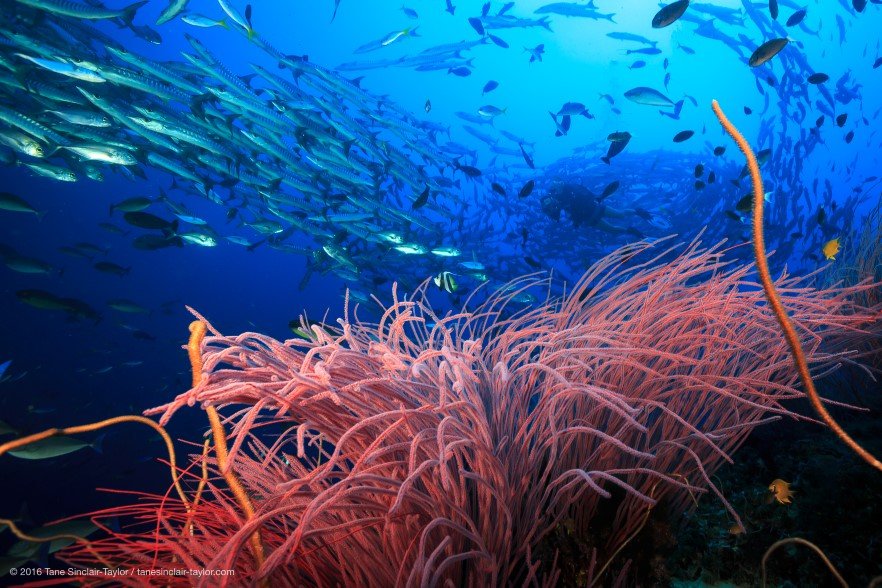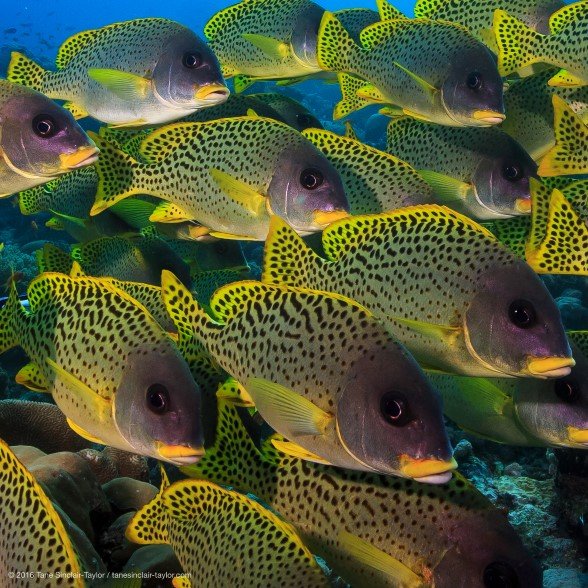‘Bright spots’ found among damaged coral reefs

IN ONE OF the largest global studies of its kind, researchers have discovered areas among depleted reefs that are heaving with fish, which have been dubbed ‘bright spots’.
Researchers conducted over 6000 reef surveys in 46 countries and found 15 bright spots, which they believe offer the potential to develop exciting new solutions for coral reef conservation.
“Given the widespread depletion of coral reef fisheries globally, we were really excited to find these bright spots that were faring much better than we anticipated,” said lead author Professor Josh Cinner from the ARC Centre of Excellence for Coral Reef Studies at James Cook University in Queensland.

A marine biologist is engulfed by a school of barracuda and jacks as she conducts reef surveys in Kimbe Bay, Papua New Guinea. (Image: Tane Sinclair-Taylor)
SEE ALSO: GALLERY: Kimbe Bay, PNG
Reefs “punch above their weight”
According to the study, published this week in the journal Nature, bright spots are reefs with more fish than expected based on their exposure to pressures such as human population, local poverty, and unfavourable environmental conditions.
“To be clear, bright spots are not necessarily pristine reefs, but rather reefs that have more fish than they should, given the pressures they face,” said Josh.
“We wanted to know why these reefs could ‘punch above their weight’ so to speak, and whether there are lessons we can learn about how to avoid the degradation often associated with overfishing.”
Globally, coral reefs are in decline and current strategies for preserving them are insufficient, according to co-author of the study, Professor Nick Graham from Lancaster University in England.
“Our bright spots approach has identified places we did not previously know were so successful, and the really interesting thing is that they are not necessarily untouched by man,” he said.

A school of blackspotted rubberlip fish form a dense school on a reef in the western Indian Ocean. (Image: Tane Sinclair-Taylor)
“We believe their discovery offers the potential to develop exciting new solutions for coral reef conservation,” Nick added.
“Importantly, the bright spots had a few things in common, which, if applied to other places, might help promote better reef conditions.”
The researchers also identified 35 ‘dark spots’ – reefs where fish numbers were in worse shape than expected.
Future prevention
This kind of study is important in creating solutions to improve the likelihood of maintaining healthy reefs and helping the recovery of degraded reefs, according to Dr Elizabeth Madin from the Department of Biological Sciences Macquarie University, who wasn’t involved in the research.
“This study is a very useful addition to our growing knowledge of what kinds of human activities, policies, and societal characteristics lead to reefs that are likely to fare well, or less so, into the future,” she said.
“Importantly, the lessons that emerge from this study are not unique to one or a few local areas, but are broadly relevant to nations and states around the world.”
RELATED:
- Coral spawning: a rare natural wonder
- Secrets of the Coral Sea revealed
- Coral reef deaths: mystery solved




